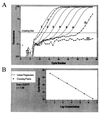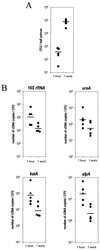Assessment of Helicobacter pylori gene expression within mouse and human gastric mucosae by real-time reverse transcriptase PCR
- PMID: 11447148
- PMCID: PMC98562
- DOI: 10.1128/IAI.69.8.4759-4766.2001
Assessment of Helicobacter pylori gene expression within mouse and human gastric mucosae by real-time reverse transcriptase PCR
Abstract
Despite increasing knowledge on the biology of Helicobacter pylori, little is known about the expression pattern of its genome during infection. While mouse models of infection have been widely used for the screening of protective antigens, the reliability of the mouse model for gene expression analysis has not been assessed. In an attempt to address this question, we have developed a quantitative reverse transcriptase PCR (RT-PCR) that allowed the detection of minute amounts of mRNA within the gastric mucosa. The expression of four genes, 16S rRNA, ureA (encoding urease A subunit), katA (catalase), and alpA (an adhesin), was monitored during the course of a 6-month infection of mice and in biopsy samples from of 15 infected humans. We found that the selected genes were all expressed within both mouse and human infected mucosae. Moreover, the relative abundance of transcripts was the same (16S rRNA > ureA > katA > alpA), in the two models. Finally, results obtained with the mouse model suggest a negative effect of bacterial burden on the number of transcripts of each gene expressed per CFU (P < 0.05 for 16S rRNA, alpA, and katA). Overall, this study demonstrates that real-time RT-PCR is a powerful tool for the detection and quantification of H. pylori gene expression within the gastric mucosa and strongly indicates that mice experimentally infected with H. pylori provide a valuable model for the analysis of bacterial gene expression during infection.
Figures




Similar articles
-
Mucosal immunization with a urease B DNA vaccine induces innate and cellular immune responses against Helicobacter pylori.Helicobacter. 2006 Apr;11(2):113-22. doi: 10.1111/j.1523-5378.2006.00385.x. Helicobacter. 2006. PMID: 16579841
-
Identification of Helicobacter pylori and the cagA genotype in gastric biopsies using highly sensitive real-time PCR as a new diagnostic tool.FEMS Immunol Med Microbiol. 2005 Jun 1;44(3):261-8. doi: 10.1016/j.femsim.2004.12.011. FEMS Immunol Med Microbiol. 2005. PMID: 15907447
-
[Comparison of four different primer sets for detection of Helicobacter pylori in gastric biopsies and oral samples by using real-time PCR].Pathol Biol (Paris). 2009 Feb;57(1):30-5. doi: 10.1016/j.patbio.2008.07.008. Epub 2008 Oct 7. Pathol Biol (Paris). 2009. PMID: 18842355 French.
-
Helicobacter pylori and antrum erosion-specific gene expression patterns: the discriminative role of CXCL13 and VCAM1 transcripts.Helicobacter. 2008 Apr;13(2):112-26. doi: 10.1111/j.1523-5378.2008.00584.x. Helicobacter. 2008. PMID: 18321301
-
Difference of p53AIP1 mRNA expression in gastric mucosa between patients with gastric cancer and chronic gastritis infected with Helicobacter pylori.J Clin Gastroenterol. 2008 Apr;42(4):351-5. doi: 10.1097/MCG.0b013e318054493e. J Clin Gastroenterol. 2008. PMID: 18277906
Cited by
-
Helicobacter pylori infection induces interleukin-8 receptor expression in the human gastric epithelium.Infect Immun. 2003 Jun;71(6):3357-60. doi: 10.1128/IAI.71.6.3357-3360.2003. Infect Immun. 2003. PMID: 12761119 Free PMC article.
-
Adhesion and Invasion of Gastric Mucosa Epithelial Cells by Helicobacter pylori.Front Cell Infect Microbiol. 2016 Nov 22;6:159. doi: 10.3389/fcimb.2016.00159. eCollection 2016. Front Cell Infect Microbiol. 2016. PMID: 27921009 Free PMC article. Review.
-
Novel luciferase reporter system for in vitro and organ-specific monitoring of differential gene expression in Listeria monocytogenes.Appl Environ Microbiol. 2006 Apr;72(4):2876-84. doi: 10.1128/AEM.72.4.2876-2884.2006. Appl Environ Microbiol. 2006. PMID: 16597994 Free PMC article.
-
A comparison of murine and human immunoproteomes of Helicobacter pylori validates the preclinical murine infection model for antigen screening.Infect Immun. 2002 Nov;70(11):6494-8. doi: 10.1128/IAI.70.11.6494-6498.2002. Infect Immun. 2002. PMID: 12379736 Free PMC article.
-
Curcumin Oxidation Is Required for Inhibition of Helicobacter pylori Growth, Translocation and Phosphorylation of Cag A.Front Cell Infect Microbiol. 2021 Dec 24;11:765842. doi: 10.3389/fcimb.2021.765842. eCollection 2021. Front Cell Infect Microbiol. 2021. PMID: 35004346 Free PMC article.
References
-
- Alarcon T, Domingo D, Lopez-Brea M. Antibiotic resistance problems with Helicobacter pylori. Int J Antimicrob Agents. 1999;12:19–26. - PubMed
-
- Alm R A, Ling L S, Moir D T, King B L, Brown E D, Doig P C, Smith D R, Noonan B, Guild B C, deJonge B L, Carmel G, Tummino P J, Caruso A, Uria-Nickelsen M, Mills D M, Ives C, Gibson R, Merberg D, Mills S D, Jiang Q, Taylor D E, Vovis G F, Trust T J. Genomic-sequence comparison of two unrelated isolates of the human gastric pathogen Helicobacter pylori. Nature. 1999;397:176–180. - PubMed
-
- Atherton J C, Cao P, Peek R M J, Tummuru M K, Blaser M J, Cover T L. Mosaicism in vacuolating cytotoxin alleles of Helicobacter pylori. Association of specific vacA types with cytotoxin production and peptic ulceration. J Biol Chem. 1995;270:17771–17777. - PubMed
-
- Buckley M J, Xia H X, Hyde D M, Keane C T, O'Morain C A. Metronidazole resistance reduces efficacy of triple therapy and leads to secondary clarithromycin resistance. Dig Dis Sci. 1997;42:2111–2115. - PubMed
MeSH terms
Substances
LinkOut - more resources
Full Text Sources
Other Literature Sources
Medical

